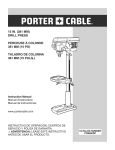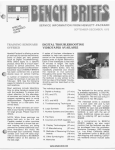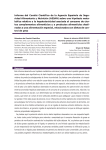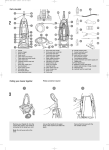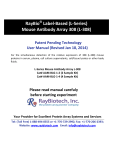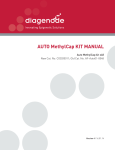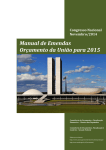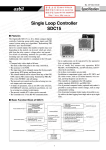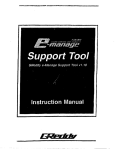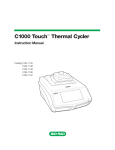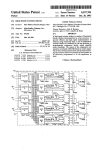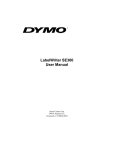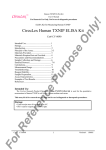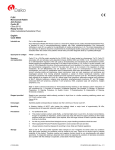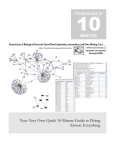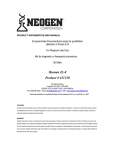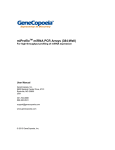Download RT2 Profiler PCR Arrays: Pathway Analysis
Transcript
RT2 Profiler PCR Arrays: Pathway Analysis Focus on Your Pathway The complete PCR array technical reference Sample & Assay Technologies Table of contents Table of contents RT Profiler PCR Arrays 3 RT2 Profiler PCR Array system 5 RT2 Profiler PCR Array performance 8 RT2 PreAMP system for FFPE samples 9 2 Popular RT2 Profiler PCR Arrays for research Cat. no.* SAP # / PCR Array # Angiogenesis 330231 / PAXX-024Y Apoptosis 330231 / PAXX-012Y Autophagy 330231 / PAXX-084Y PCR array data analysis guide 10 Breast Cancer and Estrogen Receptor Signaling 330231 / PAXX-005Y QIAGEN® RNeasy® Kits 11 Cancer PathwayFinder 330231 / PAXX-033Y QIAGEN products for sample disruption 12 QIAGEN products for RNA stabilization 13 RT Profiler PCR Array quick index 14 2 Compatible instruments Plate Cell Cycle 330231 / PAXX-020Y Chemokines and Receptors 330231 / PAXX-022Y Diabetes 330231 / PAXX-023Y DNA Damage Signaling Pathway 330231 / PAXX-029Y Drug Metabolism 330231 / PAXX-002Y 330231 / PAXX-040Y QIAGEN ® Rotor-Gene Q, Rotor-Gene 6000 R Applied Biosystems (ABI) ABI 5700, 7000, 7300 A EGF/PDGF Signaling Pathway ABI 7500 Standard, ViiATM 7 (96-well block) A Embryonic Stem Cells 330231 / PAXX-081Y ABI 7500 FAST, ViiA 7 FAST (96-well Block) C Endothelial Cell Biology 330231 / PAXX-015Y ABI 7900HT Standard (96-well Block), 7700 A ABI 7900HT FAST (96-well Block) C Epigenetic Chromatin Modification Enzymes 330231 / PAXX-085Y Epithelial to Mesenchymal Transition 330231 / PAXX-090Y Bio-Rad ABI 7900HT, ViiA 7 (384-well Block) E ABI StepOnePlusTM C iCycler®, iQTM5, MyiQTM, MyiQ2, Chromo4TM A D Extracellular Matrix and Adhesion Molecules 330231 / PAXX-013Y CFX96TM, Opticon® 2 E GPCR Signaling Pathway 330231 / PAXX-071Y A Growth Factors 330231 / PAXX-041Y CFX384TM Stratagene Mx3000P , Mx3005P ® Mx4000 ® D Heat Shock Proteins 330231 / PAXX-076Y LightCycler® 480 (96-well Block) F 330231 / PAXX-078Y LightCycler 480 (384-well Block) G Hedgehog Signaling Pathway Eppendorf Mastercycler ep realplex 2/2S, 4/4S A 330231 / PAXX-054Y TaKaRa TP-800 A Hematopoietic Stem Cells & Hematopoesis Fluidigm BioMarkTM H Hepatoxicity 330231 / PAXX-093Y Hypoxia Signaling Pathway 330231 / PAXX-032Y Inflammatory Cytokines and Receptors 330231 / PAXX-011Y Innate and Adaptive Immune Response 330231 / PAXX-052Y Roche ® ® RT2 Profiler PCR Array accessory Cat. no. 12 samples 330401 Master Mix for RT2 Profiler PCR Arrays Cat. no. RT2 First Strand Kit RT2 SYBR® Green 2 arrays (96-well) 330520 ROXTM qPCR Mastermix 12 arrays (96-well) 330522 24 arrays (96-well) 330523 RT2 SYBR Green 4 arrays (384-well) 330521 2 arrays (96-well) 330510 Interferon α,β Response 330231 / PAXX-016Y JAK/STAT Signaling Pathway 330231 / PAXX-039Y MAP Kinase Signaling Pathway 330231 / PAXX-061Y Mitochondrial Energy Metabolism 330231 / PAXX-008Y 12 arrays (96-well) 330512 Nephrotoxicity 330231 / PAXX-094Y 24 arrays (96-well) 330513 NFkB Signaling Pathway 330231 / PAXX-025Y 4 arrays (384-well) 330511 330231 / PAXX-065Y RT SYBR Green qPCR 2 arrays (96-well) 330500 Oxidative Stress and Antioxidant Defense Mastermix 12 arrays (96-well) 330502 p53 Signaling Pathway 330231 / PAXX-027Y 24 arrays (96-well) 330503 Wnt Signaling Pathway 330231 / PAXX-043Y 4 arrays (384-well) 330501 Fluor qPCR Mastermix 2 * XX = species; Y = plate format. 2 www.SABiosciences.com RT2 Profiler PCR Arrays: Pathway Analysis 01/2011 RT2 Profiler PCR Arrays What are RT2 Profiler PCR Arrays? RT² Profiler PCR Arrays are a highly reliable and sensitive gene expression profiling technology for analyzing focused panels of genes in signal transduction, biological processes, or disease research pathways using real-time PCR. Each cataloged RT2 Profiler PCR Array contains a list of the pathway-focused genes as well as 5 housekeeping (reference) genes on the array. In addition, each array contains a panel of proprietary controls to monitor genomic DNA contamination (GDC) as well as the first strand synthesis (RTC) and real-time PCR efficiency (PPC). Isolate RNA from research samples of cells, tissues, FFPE, and/or blood Why use RT2 Profiler PCR Arrays? Simplicity: The simplicity of RT2 Profiler PCR Arrays makes routine expression profiling practical in any research laboratory with a realtime instrument. Performance: RT² Profiler PCR Arrays have the sensitivity, reproducibility, specificity, and reliability to accurately profile multiple genes simultaneously in 96- and 384-well plate, 100-well disc, and 96x96 Convert total RNA to cDNA chip formats. Relevance: RT² Profiler PCR Arrays focus on profiling the genes relevant to the pathways or disease states important to your research. Control Experimental Add cDNA to RT2 SYBR Green qPCR Mastermix RT2 Profiler PCR Array plate layout 03 04 05 06 07 08 09 10 11 12 13 14 15 16 17 18 19 20 21 22 23 24 25 26 27 28 29 30 31 32 33 34 35 36 37 38 39 40 41 42 43 44 45 46 47 48 49 50 51 52 53 54 55 56 57 58 59 60 61 62 63 64 65 66 67 68 69 70 71 72 73 74 75 76 77 78 79 80 81 82 83 84 HK1 HK2 HK3 HK4 HK5 GDC RTC RTC RTC PPC PPC PPC Run in your real-time PCR instrument 1.E+001 1.E+001 1.E-000 1.E-000 Delta Rn 02 Delta Rn 01 Aliquot mixture across RT2 Profiler PCR Array 1.E-001 Housekeeping genes Genomic DNA control Reverse transcription controls Positive PCR controls 1.E-003 0 4 8 12 16 20 24 28 32 1.E-003 36 40 4 8 12 16 20 24 28 32 36 40 Cycle number Data analysis 1 10-1 10-5 10 Normal breast p-Value for fold change 10-6 -4 10-3 10-2 10-2 10-3 10-4 10-5 10-1 10-6 1 -4 -3 -2 -1 0 1 2 Fold change ratio [log2] Sample & Assay Technologies 0 Cycle Number Figure 1. Each well in an RT2 Profiler PCR Array measures the expression of a gene related to a pathway or disease state. A typical 96-well format is shown. This is also available in a 384-well plate, 100-well disc, and 96x96 chip format. RT2 Profiler PCR Arrays: Pathway Analysis 01/2011 1.E-001 1.E-002 1.E-002 3 4 10-6 10-5 10-4 10-3 10-2 10-1 1 Breast tumor 3 16 -16 12 25 8 –12 –8 –4 –4 4 8 12 16 10 –12 5 –16 RT2 PCR log2 FC 4 Figure 2. Comparable biological results.* Gene expression analysis was compared between RT2 Profiler PCR Arrays (SYBR Green-based) and the TaqMan® platform. Regression analysis of fold differences, with data normalized against POLR2A, demonstrate that both platforms yield similar biological results. Fold up-regulation 5000 125 8 10 Log [copy number] 12 Figure 3. Sensitivity with RT2 SYBR Green versus TaqMan chemistry.* PCR amplicons detected using the same primer pair with or without TaqMan probes in either SYBR Green or TaqMan chemistry. SYBR green chemistry yields earlier CTs for each dilution, demonstrating better sensitivity than TaqMan chemistry. 5005 128 119 30 20 10 0 p value IL21 IL5 PDGFA TGFB2 TNFSF11 BMP6 TNFRSPSF11B TNFSF14 IL1F7 IL9 IL13 HSPA6 CSF1 CRYAB IL11 MT2A IFNG CSF2 TNF CSF2 HSPA1A LTA DDIT3 TNF IL1B TNFSF13B IFNA5 CYP1A1 IL10 IL1A TNFSF10 HSPH1 HSPA5 HSPCA DNAJB4 1GADD45A HMOx1 1ACTB 10–9 10–8 10–7 10–6 10–5 10–4 10–3 10–2 10–1 100 IL2 IL22 IL3 IL17 BMP3 –7 –5 –3 –1 1 3 5 7 9 11 13 15 17 Fold difference [log2] Fold change mAb 225/LgG Figure 6. Relative fold change between disorganized and organized colonies using the Angiogenesis RT2 Profiler PCR Array.† RNA isolated from unorganized T4-2 cells treated with a control antibody (IgG) or reverted to an organized colony by blocking EGFR signaling (mAb225) was reverse transcribed and relative gene expression data was obtained using the human Angiogenesis RT2 Profiler PCR Array. The expression profile of 84 genes relevant to angiogenesis as well as 5 housekeeping genes were assayed. Fold change calculations were done using SABiosciences’ data analysis software which automatically calculates the fold change in gene expression between the treated and control groups. 6 Actos™ Avandia® Rezulin® 18SrRNA Figure 5. Common Cytokine RT2 Profiler PCR Array identified 23 up-regulated and 6 down-regulated genes following PBMC stimulation. Triplicate total RNA samples from human peripheral blood mononuclear cells (either untreated or stimulated with 50 ng/ml PMA and 1 mg/ml ionomycin for 6 hours) were characterized with the human Common Cytokine RT2 Profiler PCR Array. Twenty-three cytokine genes are up-regulated (> 5-fold, p < 0.0005) including interleukins, colony stimulating factors, and TNF ligands after 6 hours of stimulation. Six interleukin and TNF ligand genes are down-regulated under the same conditions. SYBR Green E = 100% R2 = 0.9999 15 –8 Figure 4. Stress and Toxicity PathwayFinder RT2 Profiler PCR Array uncovered distinct gene expression profiles associated with liver toxicity caused by 3 PPARγ agonists. RNA from HepG2 cells treated with three different glitazone PPARγ agonists for type 2 diabetes mellitus was characterized, and the results were compared to that of a vehicle (DMSO) control. The drug withdrawn due to idiosyncratic liver toxicity (Rezulin), induces very different changes in the expression of stress-related genes than two safer drugs still on the market (Avandia and Actos). TaqMan E = 100% R2 = 0.9998 20 4 CT TaqMan log2 FC R = 0.97 Slope = 0.99 86 genes 50 0 –50 –100 –150 –200 IL8 PGF MMP9 NRP2 EREG THBS1 PECAM1 IL6 ENG PTGS1 MDK FGF2 VEGFC SPHK1 TGFB1 ACTB VEGFA IL1B TGFA TIMP1 LAMA5 ECGF1 CXCL10 TNFA B2M FGFR3 JAG1 SERPINF1 FIGF TIMP3 FGF1 ANGPT1 * Arikawa, E., et al. (2008) Cross-platform comparison of SYBR Green real-time PCR with TaqMan PCR, microarrays and other gene expression measurement technologies evaluated in the MicroArray Quality Control (MAQC) study. BMC Genomics 9, 378. † Chen, A., et al. (2009) Endothelial cell migration and vascular endothelial growth factor expression are the result of loss of breast tissue polarity. Cancer Research 69, 6721. 4 www.SABiosciences.com RT2 Profiler PCR Arrays: Pathway Analysis 01/2011 RT2 Profiler PCR Array system How the RT2 Profiler PCR Array system works RT2 Profiler PCR Arrays are a complete system for pathway-focused gene expression analysis. From sample preparation to data analysis, the RT2 Profiler PCR Array system includes four components that guarantee high-quality, reproducible, and reliable gene expression data. Integral to the performance of the RT2 Profiler PCR Array system is a proprietary set of control elements that enhance the reliability of your data and serve as a guarantee for performance over time. These elements allow researchers to quickly assess the quality of their data by determining if samples were contaminated with genomic DNA (gDNA), the quality of the reverse transcription reaction, and real-time PCR efficiency. Each component of the RT2 Profiler PCR Array system contributes to these quality control elements by incorporating an interlocked system for comprehensive monitoring of each step of the Cells, tissues, FFPE, blood, and biofluids RNeasy Kits Each pathway-focused RT2 Profiler PCR Array includes 89 wet bench RNA isolation RT2 Profiler PCR Arrays 5-120 minutes process. verified RT2 qPCR Primer Assays (including 5 housekeeping genes) and a proprietary control panel. Total RNA reference dyes (ROX, Fluorescein or without). Buffer GE RT enzyme RT First Strand Kit 2 elimination buffer essential for eliminating residual gDNA, ensuring specific detection of mRNA. Random hexamers External RNA control (RTC) Resolution Reverse transcription the quality of input RNA. It also features a proprietary genomic DNA 15 minutes Oligo-dTs An external RNA control detected by the RT2 Profiler PCR Array tests RT2 First Strand Kit algorithm provides high amplification efficiencies. Available with 5 minutes A unique formulation of buffers that co-evolved with the primer design Genomic DNA elimination RT2 SYBR Green qPCR Mastermixes dNTPs Free data analysis software analysis tool, go from raw CT values to fold change results displayed Heat activation an abundance of data. With our free RT2 Profiler PCR Array data 10 minutes pathway-focused set of genes over a wide range of detection yields Hot-start DNA polymerase dNTPs matter of minutes. SYBR Green dye DNA polymerase binding Cycling & detection 120 minutes (40 cycles) in a variety of formats (scatter plots, volcano plots, clustergram) in a RT2 SYBR Green qPCR Mastermix First strand cDNA The power of the RT2 Profiler PCR Array to assess the expression of a Elongation SYBR Green binding Detection RT2 Profiler PCR Arrays: Pathway Analysis 01/2011 Sample & Assay Technologies 5 A B 40 Untreated Clean of gDNA 35 CT GDC 10 GE treated Average CT (RTC-PPC) 45 30 25 20 15 10 HEK293T cells Mouse spinal Mouse brain tissue tissue Rat brain tissue RNA source 8 6 Fail 4 Pass 2 0 None Mg2+ Addition / treatment TRIzol® A Elimination of genomic DNA contamination. RNA from HEK 293T cells, mouse spinal tissue, mouse brain tissue, Figure 7. n or rat brain tissue was characterized on RT² Profiler PCR Arrays before (light blue bars) and after (dark blue bars) treatment B Monitoring inhibition in reverse transcription. Human universal with gDNA Elimination Buffer from the RT² First Strand Kit. n RNA was added with magnesium salt to simulate RNA degradation or added with TRIzol® reagent to simulate contamination that inhibits enzyme activity. RT² First Strand Kit was used for cDNA synthesis. layout examples Custom Gene RT2 Profiler PCR Array: plate formats 96-well format 384-well format What are custom RT2 Profiler PCR Arrays? Custom RT2 Profiler PCR Arrays employ a high-throughput approach for profiling the expression of your genes of interest. Choose from any gene in the human, mouse, rat, rhesus 12 genes - 8 samples/plate 16 genes - 24 sample/plate macaque, drosophila, or dog genomes (up to 384 different genes). Whether your interests are in biomarker discovery, microarray followup, drug development, disease characterization, or signal transduction mechanisms, custom RT2 24 genes - 4 samples/plate 32 genes - 12 sample/plate Profiler PCR Arrays enable focused expression analysis on your genes of interest. Why custom RT2 Profiler PCR Arrays? Performance: Each assay in a custom 32 genes - 3 samples/plate 48 genes - 8 samples/plate RT² Profiler PCR Array is designed and wet bench-verified using a set of rigorous parameters to insure the genes in your sample across a wide dynamic range are reproducibly recognized and quantified. 48 genes - 2 samples/plate 96 genes - 4 sample/plate Flexibility: Custom RT² Profiler PCR Arrays are available in a number of easy-to-use formats for quick sample loading and data analysis. Turnaround time: Submit your custom gene list and receive your custom RT2 Profiler 96 genes - 1 sample/plate 6 384 genes - 1 sample/plate www.SABiosciences.com PCR Arrays in approximately 2 weeks. RT2 Profiler PCR Arrays: Pathway Analysis 01/2011 Fold change over WT 8 6 MECP2-Tg MECP2-null 4 Activated Repressed 2 0 –2 –4 Gene –6 Figure 8. Gene expression changes in hypothalamus of MECP2 mouse models. Validation of expression changes for 66 genes by qPCR analysis. Gene expression levels from microarray analyses were validated in four MECP2-Tg males and four Mecp2-null males. Data is plotted as relative up-regulation (light blue) or down-regulation (dark blue) over wild-type (P < 0.05, t test). Each column represents a single gene, and represents data from four samples for each genotype.* Custom RT2 Profiler PCR Array: Rotor-Gene Q format 96-well plate† or 100-well disc custom RT2 Profiler PCR Arrays Format Number of arrays (minimum) 8 genes, 12 samples/plate 12 genes, 8 samples/plate 100-well disc format 12 16 genes, 6 samples/plate 24 genes, 4 samples/plate 32 genes, 3 samples/plate 48 genes, 2 samples/plate 24 96 genes, 1 sample/plate All formats Per additional 12 arrays 384-well custom RT2 Profiler PCR Arrays Format 12 genes - 8 sample/plate Number of arrays (minimum) 8 genes, 48 samples/plate 12 genes, 32 samples/plate 6 16 genes, 24 samples/plate 24 genes, 16 samples/plate 32 genes, 12 samples/plate 48 genes, 8 samples/plate 64 genes, 6 samples/plate 6 96 genes, 4 samples/plate 96 genes - 1 sample/plate 128 genes, 3 sample/plate 192 genes, 2 samples/plate 24 384 genes, 1 sample/plate All formats Modified RT2 Profiler PCR Arrays Add up to 4 genes to a cataloged RT2 Profiler PCR Array (96-well, 100-well disc) Add up to 4 genes to a cataloged RT2 Profiler PCR Array (384-well) Per additional 6 arrays Number of arrays (minimum) RT2 Profiler PCR Array accessories Pack size Catalog # RT PreAMP cDNA Synthesis Kit 12 samples 330451 RT2 PreAMP Pathway Primer Mixes (pathway focused) 12 samples 330241 2 24 4 * Chahrour, M., et al. (2008) MeCP2, A key contributor to neurological disease, activates and represses transcription. Science 320, 1224. † Also available in 96x96 Fluidigm® BioMark format. RT2 Profiler PCR Arrays: Pathway Analysis 01/2011 Sample & Assay Technologies 7 RT2 Profiler PCR Array performance Signal [-d(RFU/dT] 0.5 RT2 Profiler PCR Arrays are used and trusted by thousands of research CXCR1 CXCR2 CXCL2 CXCL3 0.4 0.3 scientists for pathway-focused gene expression analysis. Several factors, including the RT2 qPCR Primer Assay design algorithm, the proprietary 0.2 control panel, and the strict manufacturing and quality control procedures, 0.1 ensure the outstanding performance and reliability of our RT2 Profiler 0 PCR Arrays. Each RT2 Profiler PCR Array and every RT2 qPCR Primer –0.1 40 50 60 70 Tm [°C] 80 90 99 Assay is wet bench-verified to guarantee their performance, with results demonstrating several performance parameters illustrated here. Figure 9. RT Profiler PCR Arrays amplify a single genespecific product in every reaction. Universal total RNA was characterized for four chemokine and chemokine receptors using RT2 qPCR Primer Assays, followed by a dissociation (melt) curve analysis. RT2 Profiler PCR Arrays specifically detect individual genes despite the expression of related gene family members in the same RNA sample. 2 Distinct specificity The complete RT2 Profiler PCR Array system, with high quality input RNA, is guaranteed to yield single bands without primer dimers or other secondary products. The proprietary primer design algorithm incorporates more than 10 thermodynamic and sequence alignment criteria, and our wet bench verification provides confidence that every 120 PreAMP real-time qPCR assay accurately represents the expression of the queried Unamp % positive call 100 gene. Over 20,000 gene-specific RT2 qPCR Primer Assays have been 80 designed and shipped to satisfied customers. 60 40 High sensitivity and wide dynamic range 20 A key benefit of using pathway-focused RT2 Profiler PCR Arrays for 0 100 50 25 10 Input RNA [ng] 1 Figure 10. RT2 Profiler PCR Arrays detect as little as 1 ng of RNA. Different amounts of universal total RNA were characterized using the Human Inflammatory Cytokines and Receptors RT2 Profiler PCR Array (PAHS-011) with or without PreAMP. The percentage of detectable genes was calculated for each RNA amount, with 1 ng RNA analysis enabled with the new pathway-focused PreAMP technology. gene expression analysis is that genes that are over expressed can be measured as reliably as those that are under expressed. The complete RT2 Profiler PCR Array system yields > 85% positive call with 25 ng – 5 µg RNA or > 90% with as little as 1 ng PreAMP RNA with the RT2 PreAMP System. The 8-log wide dynamic range provided by real-time PCR is unparalleled when comparing a pathway-focused gene panel of varying expression levels across a variety of samples. 9.95 Figure 11. RT2 Profiler PCR Arrays detect RNA across a wide dynamic range. Ten-fold serial dilutions of human CHRNA5 were characterized with the respective RT2 qPCR Primer Assay. Fluorescence 7.95 5.95 109 108 107 3.95 105 104 103 102 101 1 1.95 0 0 8 106 2 4 6 8 10 12 14 16 18 20 22 24 26 28 30 32 34 36 38 40 Cycle number www.SABiosciences.com RT2 Profiler PCR Arrays: Pathway Analysis 01/2011 RT2 PreAMP System for FFPE samples Gene expression analysis from FFPE samples An innovative solution enabling the accurate qRT-PCR analysis of formalin-fixed paraffin-embedded (FFPE) samples. The RT² PreAMP technology utilizes multiplex tandem PCR to preamplify gene-specific cDNA with minimal bias. This kit is intended for preamplification of first-strand cDNA from fragmented total RNA from FFPE samples for gene expression analysis with RT² Profiler PCR Arrays. y = 0.9749x – 0.0589 R2 = 0.9187 The combination of a simplified RNA extraction and a high-fidelity amplification process maximizes recovery of RNA. RT² Profiler PCR Arrays a biological pathway or a disease state from FFPE samples. Benefits of RT2 PreAMP system for FFPE samples 2.0 1.0 FFPE ∆∆CT facilitate easy and reliable expression analysis of genes associated with 3.0 –5.0 –4.0 –3.0 –2.0 –1.0 –1.0 1.0 2.0 3.0 –2.0 –3.0 Quick and efficient: High quality and high-yield total RNA from FFPE samples with RNeasy FFPE Mini Kit Superior sensitivity: RT2 PreAMP protocol significantly enhances qRT-PCR detection sensitivity for FFPE samples Easy workflow: Simple procedure and robust performance RT2 PreAMP performance Increased positive call rate from FFPE samples –4.0 –5.0 PreAMP ∆∆CT Figure 12. Highly comparable gene expression fold change results between FFPE preamplified and unamplified samples. RNA extracted from FFPE spleen and intestine samples were extracted and converted to cDNA with and without preamplification. All 4 cDNAs were analyzed on the Human Cancer PathwayFinder RT2 Profiler PCR Array. The ∆∆CT comparison and genes with raw CT values lower than 33 in both unpreamplified spleen and intestine samples are presented. Increased detection of genes previously classified as “absent” Unbiased amplification of preamplified genes Faithful conservation of biological changes 45 RT only Raw CT 40 Figure 13. Genes extracted from FFPE samples previously classified as “absent” are now detectable after RT2 PreAMP preamplification. RNA was extracted from FFPE spleen sample (human) kit and reverse transcribed to cDNA using RT2 preamplification (dark blue bars) and without PreAMP (light blue bars). Results of the Human Cancer PathwayFinder RT2 Profiler PCR Array showed 55% of unpreamplified genes were virtually undetectable with no genes in the 10-20 CT range. Preamplified genes with CT values > 30, shift into the reliably quantitative range (CT = 10-30). RT + PreAMP 35 30 25 20 B1 N IF PT 1 DC 25 A JU N G C IS T1 AN P3 M TW RT TI P1 M TE ET M A1 M 2 N FR IF FG N 2A E2 F1 C DK C AS P8 15 Ordering Information Product Cat. no. RT2 PreAMP cDNA Synthesis Kit 330451 RT2 PreAMP Pathway Primer Mixes for all RT2 Profiler PCR Arrays 330241 RT2 PreAMP Primer Mixes for custom RT2 Profiler PCR Arrays 330141 RT2 Profiler PCR Arrays Varies RT SYBR Green qPCR Mastermixes Varies 2 RNeasy FFPE Kit (50) RT2 Profiler PCR Arrays: Pathway Analysis 01/2011 73504 Sample & Assay Technologies 9 RT2 Profiler PCR Array data analysis Free web-based RT2 Profiler PCR Array data analysis software This integrated web-based software package for the RT2 Profiler PCR Array system automatically performs all ΔΔCT based fold-change calculations from your uploaded raw threshold cycle data. Simply providing the array’s catalog number annotates the results to the correct gene list. The web portal delivers results not only in a tabular format but also in scatter, volcano, cluster-gram, and multi-group plots. Perform any pair-wise comparison between groups of experimental replicates by defining your own fold-change and statistical significance thresholds, or compare all of the groups side-by-side. The web portal also helps to correctly interpret the genomic DNA, reverse transcription efficiency, and positive PCR control well data. Make your pathway-focused gene expression analysis quick and painless with the RT2 Profiler PCR Array system and the RT2 Profiler PCR Array Data Analysis Suite. Simple: Just upload your data and define your parameters* Convenient: No downloading or installation required Publication-ready output: Export all results as free Excel® files or png image files *Excel-based data analysis templates are available from our website. Instructions 1. Upload your data in a simple Excel file format. 2. Define your housekeeping genes and experimental groups. 3. Choose an automatically generated data analysis result Take a test run with pre-loaded sample data set today: www.SABiosciences.com/pcrarraydataanalysis.php Join our next live webinar entitled: “PCR Array Data Analysis Tutorial” at: www.SABiosciences.com/seminarlist.php Figure 14. The volcano plot indicates the statistical significance of gene expression changes. The x-axis plots the log2 of the fold-differences, while the y-axis plots their p-values based on student’s t-test of your replicate raw CT data. The blue and red symbols outside the gray area conveniently have the same meaning as the scatter plot. Symbols in the volcano plot above the dashed line readily identify fold-differences at least as statistically significant as a threshold that can be defined. 10 www.SABiosciences.com RT2 Profiler PCR Arrays: Pathway Analysis 01/2011 QIAGEN RNeasy Kits What are RNeasy Kits? RNeasy Kits are a proven technology for rapid and convenient purification of high-quality RNA. Reproducible yields of intact RNA with high Agilent® RIN (RNA integrity number) values are obtained, enabling reliable results in downstream applications such as real-time RT-PCR. Kits are available for cells and easy-to-lyse tissues as well as for more challenging samples, such as fiber-rich or fatty tissues, fine needle aspirates, and cryosections. Why use RNeasy Kits? Sample When purifying RNA, it is important to use a method that maintains RNA integrity and removes Lyse, homogenize, and add ethanol contaminants. Degradation of RNA makes reliable analysis of gene expression impossible, while the presence of contaminants in the purified RNA can inhibit enzymes in downstream applications such as real-time RT-PCR and microarray analysis. RNeasy Kits overcome Bind total RNA to RNeasy membrane these challenges through the combination of a specialized lysis buffer and silica-membrane technology. How do RNeasy Kits work? Wash Biological samples are first lysed in a lysis buffer that contains a guanidine salt, which fully denatures RNases to prevent RNA degradation. RNA is then specifically bound to a silica membrane, either in an RNeasy spin column or the well of an RNeasy 96 plate. Other cellular Elute in small volume material is efficiently washed away using a series of wash buffers before pure, intact RNA is eluted in RNase-free water. Ready-to-use RNA B A 1799.4 nt 400 300 FU 10 100 00 40 00 0 10 min 20 5 min 10 00 131.0 nt 0 0 min 200 25 RFU 4628.7 nt 20 0 50 0 20 Figure 15. Highly intact RNA. RNA was purified from Jurkat cells using the RNeasy Mini Kit. The purified RNA was analyzed A QIAxcel® system (ratio of 28S to 18S rRNA: 1.55) and n B Agilent 2100 Bioanalyzer (ratio of 28S to 18S rRNA: on the n 1.7). A high RNA integrity number (RIN) of 9.6 was obtained, indicating highly intact RNA. Ordering Information Product Contents Cat. no. RNeasy Mini Kit (50)* For purification of RNA from cells & easy-to-lyse tissues 74104 RNase-Free DNase Set (50) For DNase digestion RNA purification 79254 RNeasy Fibrous Tissue Mini Kit (50)* For purification of RNA from fiber-rich tissues 74704 RNeasy Plus Universal Mini Kit (50)* For purification of RNA from all tissue types 73404 RNeasy 96 Kit (12) For purification of RNA from cells in 96-well format 74182 QIAzol Lysis Reagent (200 ml) For lysis of fatty and standard tissues before RNA isolation 79306 ® * Automatable on the QIAcube. Find out more at www.qiagen.com/goto/QIAcube. RT2 Profiler PCR Arrays: Pathway Analysis 01/2011 Sample & Assay Technologies 11 QIAGEN products for sample disruption What is sampleIFNA5 disruption? IL1F7 IFNG CSF2 IL9 IL2 IL1B IL11 IL22 IL3 Effective disruptionTNFSF13B and homogenization of a biological sample is an absolute requirement for all RNA purification IL21 IL5 IL13 TNFSF10 procedures. Disruption IL1A releases the RNA contained IL17 in a sample, while homogenization reduces sample viscosity to facilitate H3K27me3 Control lgG RNA concentration [ng/μl] subsequent RNA purification. 400 TissueLyser LT Why use QIAGEN sample disruption products? TissueLyser II QIAGEN provides a range of technologies for disruption and 300 homogenization — from QIAshredder spin columns for fast and simple 200 homogenization of cell lysates to TissueRuptor and TissueLyser systems 100 0 for mechanical disruption and homogenization of tougher tissue samples at a range of throughputs. TissueRuptor and TissueLyser systems deliver Skin Heart Lung Brain Figure 16. Effective tissue disruption. Various rat tissues were disrupted using the TissueLyser LT or TissueLyser II. RNA was purified from 20 mg samples on the QIAcube® using the RNeasy Fibrous Tissue Mini Kit (skin, heart, RNA Mini Source and lung) or RNeasy Lipid Tissue Kit (brain). RNA was eluted in a volume of 50 µl, and concentration was determined using a spectrophotometer. fast and effective disruption, and replace tedious and time-consuming methods such as disruption using a mortar and pestle. How do QIAGEN sample disruption products work? The QIAshredder is a biopolymer-shredding system in a spin-column format. Cell lysate is applied to a QIAshredder spin column, which is then briefly centrifuged to homogenize the lysate. The TissueRuptor is a handheld device that provides simultaneous disruption and homogenization using TissueRuptor Disposable Probes, which contain a blade that rotates at very high speeds. As the probes are both disposable and transparent, the risk of cross-contamination is minimized and the sample disruption process can be visually monitored. Use of disposable probes also saves time as there is no need to clean the same probe after disrupting each sample. TissueLyser instruments are bead mills that simultaneously disrupt and homogenize samples through high-speed shaking with grinding beads in plastic tubes. Using an adapter that holds several tubes, the instruments disrupt multiple samples at the same time — up to 12 samples with the TissueLyser LT, and up to 48 or 192 samples with the TissueLyser II. Ordering Information Product Contents Cat. no. QIAshredder (50) For homogenization of cell lysates TissueRuptor For disruption of individual samples ® 79654 9001271 TissueRuptor Disposable Probes (25) Disposable probes for use with the TissueRuptor TissueLyser LT For disruption of up to 12 samples 85600 TissueLyser LT Adapter, 12-tube For purification of RNA from cells in 96-well format 69980 TissueLyser II For disruption of up to 48 or 192 samples 85300 TissueLyser Adapter Set 2 x 24 Adaptor set for use with the TissueLyser II; holds 48 tubes 69982 12 www.SABiosciences.com 990890 RT2 Profiler PCR Arrays: Pathway Analysis 01/2011 QIAGEN products for RNA stabilization and transported at ambient temperature prior to RNA purification. For further convenience, stabilization reagents are also available as part of QIAGEN kits for RNA purification. Ordering Information Product s hr 2 4 s hr 24 s hr PBS 1 0.1 0.01 s hr s 0.001 24 the gene expression profile, and can then be conveniently handled s hr hr Samples are simply submerged in the reagents to immediately preserve 24 s of hazardous liquid nitrogen or dry ice to freeze samples is avoided. s hr 4 of RNA in cells, tissues, blood, and saliva at room temperature. The use 4 Allprotect s QIAGEN provides a broad range of reagents for convenient stabilization 10 hr Why use QIAGEN RNA stabilization products? B s hr 2 to sample disruption and RNA purification. 0 2 Fold change in transcript level hazardous, and care should be taken to avoid thawing of samples prior 20 hr liquid nitrogen or on dry ice. However, the use of such chemicals is 40 s RNA stabilization is usually achieved by rapidly freezing samples in 60 2 critical for accurate gene expression analysis. 80 hr Immediate stabilization of cellular RNA to preserve mRNA levels is PBS 24 downregulation triggered by sample manipulation will also occur. Allprotect s unstable. The RNA is degraded by RNases, and gene induction or 100 hr Once a biological sample is harvested, its RNA becomes extremely Fold change in transcript level A 4 What is RNA stabilization? Figure 17. Effective RNA stabilization. Rat tissues were stored at 25ºC for 2–24 hours in Allprotect Reagent or PBS prior to A Rat lung tissue was analyzed real-time RT-PCR analysis. n B Rat intestine tissue was analyzed for c-fos expression. n for Madh7 expression. Transcript levels relative to those in liquid nitrogen stabilized tissues were calculated. Changes in transcript levels were prevented by Allprotect Reagent. Contents Cat. no. Allprotect Tissue Reagent (100 ml) For stabilization of RNA, DNA, & protein in tissues 76405 AllPrep DNA/RNA Mini Kit (50) For simultaneous purification of DNA and RNA 80204 RNAlater® RNA Stabilization Reagent (250 ml) For stabilization of RNA in tissues 76106 RNeasy Protect Mini Kit (50) For stabilization of RNA in tissues and RNA purification 74124 RNAprotect Cell Reagent (250 ml) For stabilization of RNA in cells 76526 RNAprotect Animal Blood Tubes (50 x 100 µl) For collection of 100 µl animal blood with RNA stabilization 76544 RNeasy Protect Animal Blood Kit (50) For purification of RNA from blood collected in RNAprotect Animal Blood Tubes 73224 miRNeasy Protect Animal Blood Kit (50) For purification of RNA, including miRNA, from blood collected in RNAprotect Animal Blood Tubes ® ® 217304 For up-to-date licensing information and product-specific disclaimers, see the respective QIAGEN kit handbook or user manual. QIAGEN kit handbooks and user manuals are available at www.qiagen.com or can be requested from QIAGEN Technical Services or your local distributor. “RNAlater®” is a trademark of AMBION, Inc., Austin, Texas and is covered by various U.S. and foreign patents. Trademarks: QIAGEN® , QIAcube®, QIAxcel®, QIAzol®, AllPrep®, RNAprotect®, RNeasy®, Rotor-Gene®, TissueRuptor®, (QIAGEN Group); SYBR® (Molecular Probes, Inc.); Roche®, LightCycler®, TaqMan® (Roche Group); Applied Biosystems®, ROX™, StepOnePlus™, (Applera Corporation or its subsidiaries); , Eppendorf®, Mastercycler® (Eppendorf AG); Stratagene®, Mx3005P®, Mx3000P®, Mx4000® (Stratagene); Bio-Rad®, iCycler®, Chromo4™, CFX96™, DNA Engine Opticon®, CFX384™, iQ™, MyiQ™ (Bio-Rad Laboratories, Inc.); Fluidigm®, BioMark™ (Fluidigm Corp.); Agilent® (Agilent Technologies, Inc.); Excel® (Microsoft Corporation); TRIzol® (Molecular Research Center, Inc.); Actos® (Takeda Pharmaceutical Company Limited); Avandia® (GlaxoSmithKline); Rezulin® (Parke-Davis Pharmaceuticals, Ltd.). Registered names, trademarks, etc. used in this document, even when not specifically marked as such, are not to be considered unprotected by law. © 2011 QIAGEN, all rights reserved. RT2 Profiler PCR Arrays: Pathway Analysis 01/2011 Sample & Assay Technologies 13 RT2 Profiler PCR Array quick index Research area RT2 Profiler PCR Array listing For catalog numbers, see page 2 or visit: www.SABiosciences.com/ArrayList.php Try RT2 Profiler PCR Arrays Apoptosis Research Cancer Research Cell Cycle Research Apoptosis Alzheimer’s Disease Angiogenesis Apoptosis Autophagy Angiogenesis Apoptosis Autophagy Cancer PathwayFinder Breast Cancer and Estrogen Receptor Signaling Breast Cancer and Estrogen Receptor Signaling Cancer PathwayFinder Cell Cycle Cancer PathwayFinder Cancer Drug Resistance and Metabolism Cell Cycle DNA Damage Signaling Pathway Cell Surface Markers Cancer PathwayFinder DNA Damage Signaling Pathway DNA Repair Dendritic and Antigen Presenting Cell Cell Cycle DNA Repair Endothelial Cell Biology Epigenetic Chromatin Modification Enzymes DNA Damage Signaling Pathway Epithelial to senchymal Transition (EMT) Heat Shock Proteins Epigenetic Chromatin Remodeling Factors EGF/PDGF Signaling Pathway MAP Kinase Signaling Pathway NFκB Signaling Pathway Epithelial to esenchymal Transition (EMT) Epithelial to Mesenchymal Transition (EMT) mTOR Signaling Oxidative Stress and Antioxidant Defense Extracellular Matrix and Adhesion Molecules MAP Kinase Signaling Pathway Neurogenesis and Neural Stem Cell p53 Signaling Pathway Glucose Metabolism p53 Signaling Pathway NFκB Signaling Pathway PI3K-AKT Signaling Pathway Hematopoietic Stem Cells and Hematopoiesis PI3K-AKT Signaling Pathway p53 Signaling Pathway Stress and Toxicity PathwayFinder Homeobox (HOX) Genes Protein Phosphatases PI3K-AKT Signaling Pathway TNF Ligand and Receptor Mesenchymal Stem Cell TGFβ BMP Signaling Pathway Protein Phosphatases Tumor Suppressor Genes Stem Cell Tumor Metastasis Signal Transduction PathwayFinder Ubiquitination Pathway T-cell and B-cell Activation Tumor Suppressor Genes Transcription Factors Unfolded Protein Response Th1-Th2-Th3 WNT Signaling Pathway Ubiquitination Pathway Risk-free starter pack offer details: www.SABiosciences.com/PCRguide.php Biomarker Research RT2 Profiler PCR Array free data analysis tool, see page 10. http://sabiosciences.com/pcrarraydataanalysis.php 14 www.SABiosciences.com RT2 Profiler PCR Arrays: Pathway Analysis 01/2011 Inflammation Research ECM/Adhesion Research Neuroscience Research Signal Transduction Research Stem Cell Research Toxicology/Drug ADME Research Chemokines & Receptors Angiogenic Growth Factors & Angiogenesis Inhibitors Alzheimer's Disease cAMP/Ca2+ Signaling PathwayFinder Adipogenesis Cancer Drug Resistance and Metabolism Common Cytokine Atherosclerosis Apoptosis EGF/PDGF Signaling Pathway Dendritic and Antigen Presenting Cell Cancer PathwayFinder Inflammasomes Chemokines and Receptors Autophagy G Protein Coupled Receptors Embryonic Stem Cells Cardiotoxicity Inflammatory Cytokines and Receptors Common Cytokine Drug Transporters GPCR Signaling PathwayFinder Hedgehog Signaling Pathway Cell Cycle Inflammatory Response and Autoimmunity Embryonic Stem Cells Embryonic Stem Cells Heat Shock Proteins Hematopoietic Stem Cells and Hematopoiesis DNA Damage Signaling Pathway Interferon α, β Response Endothelial Cell Biology GPCR Signaling PathwayFinder Hedgehog Signaling Pathway Homeobox (HOX) Genes Drug Metabolism Interferon and Receptor Extracellular Matrix and Adhesion Molecules Heat Shock Proteins Insulin Signaling Pathway Lipoprotein Signaling and Cholesterol Metabolism Drug Metabolism: Phase I Enzymes JAK/STAT Signaling Pathway Glycosylation Hedgehog Signaling Pathway JAK/STAT Signaling Pathway Mesenchymal Stem Cell Drug Metabolism: Phase II Enzymes NFκB Signaling Pathway MAP Kinase Signaling Pathway Huntington's Disease MAP Kinase Signaling Pathway Neurogenesis and Neural Stem Cell Drug Transporters T Cell Anergy & Immune Tolerance Mesenchymal Stem Cell Hypoxia Signaling Pathway mTOR Signaling Neurotrophin & Receptors GPCR Signaling PathwayFinder T-cell and B-cell Activation NFκB Signaling Pathway Mesenchymal Stem Cell NFκB Signaling Pathway Notch Signaling Pathway Hepatotoxicology TGFβ BMP Signaling Pathway Osteogenesis Neurogenesis and Neural Stem Cell Nuclear Receptors and Coregulators Osteogenesis Lipoprotein Signaling & Cholesterol Metabolism Th17 for Autoimmunity and Inflammation TGFβ BMP Signaling Pathway Neuroscience Ion Channels and Transporters PI3K-AKT Signaling Pathway Stem Cell Signaling Mitochondria Th1-Th2-Th3 TNF Ligand and Receptor Neurotransmitter Receptors and Regulators Signal Transduction PathwayFinder T-cell and B-cell Activation Molecular Toxicology 384HT TNF Ligand and Receptor Tumor Metastasis Neurotrophin and Receptors TGFβ BMP Signaling Pathway Terminal Differentiation Marker Nephrotoxicity Toll-Like Receptor Signaling Pathway VEGF Signaling Nitric Oxide Signaling Pathway Transcription Factors TGFβ BMP Signaling Pathway Oxidative Stress and Antioxidant Defense Tumor Necrosis Factor (TNF) Ligand and Receptor Wound Healing Notch Signaling Pathway Wnt Signaling Pathway Wnt Signaling Pathway Stress and Toxicity PathwayFinder RT2 Profiler PCR Arrays: Pathway Analysis 01/2011 Sample & Assay Technologies 15 www.SABiosciences.com www.qiagen.com USA n Orders 1-301-503-3187 n Fax 1-301-465-9859 n Technical 1-888-503-3187 Australia n Orders 1-800-234-800 n Fax 03-9840-9888 n Technical 1-800-243-066 Austria n Orders 0800-28-10-10 n Fax 0800-28-10-19 n Technical 00800-22448000 Belgium n Orders 0800-79612 n Fax 0800-79611 n Technical 00800-22448000 Brazil n Orders 0800-557779 n Fax 55-11-5079-4001 n Technical 0800-557779 Canada n Orders 800-572-9613 n Fax 800-713-5951 n Technical 800-362-7737 China n Orders 86-21-3865-3865 n Fax 86-21-3865-3965 n Technical 800-988-0325 Denmark n Orders 80-885945 n Fax 80-885944 n Technical 00800-22448000 Finland n Orders 0800-914416 n Fax 0800-914415 n Technical 00800-22448000 France n Orders 01-60-920-926 n Fax 01-60-920-925 n Technical 00800-22448000 Germany n Orders 02103-29-12000 n Fax 02103-29-22000 n Technical 00800-22448000 Ireland n Orders 1-800-555-049 n Fax 1-800-555-048 n Technical 00800-22448000 Italy n Orders 800-789-544 n Fax 02-334304-826 n Technical 00800-22448000 Japan n Orders 03-5547-0811 n Fax 03-5547-0818 n Technical 03-5547-0811 Luxembourg n Orders 8002-2076 n Fax 8002-2073 n Technical 00800-22448000 Mexico n Orders 01-800-7742-639 n Fax 01-800-1122-330 n Technical 01-800-7742-436 Netherlands n Orders 0800-0229592 n Fax 0800-0229593 n Technical 00800-22448000 Norway n Orders 800-18859 n Fax 800-18817 n Technical 00800-22448000 Singapore n Orders 1800-742-4362 n Fax 65-6854-8184 n Technical 1800-742-4368 Sweden n Orders 20-790282 n Fax 020-790582 n Technical 00800-22448000 Switzerland n Orders 055-254-22-11 n Fax 055-254-22-13 n Technical 00800-22448000 UK n Orders 01293-422-91 n Fax 01293-422-922 n Technical 00800-2244800 1061743 01/2011 Sample & Assay Technologies

















